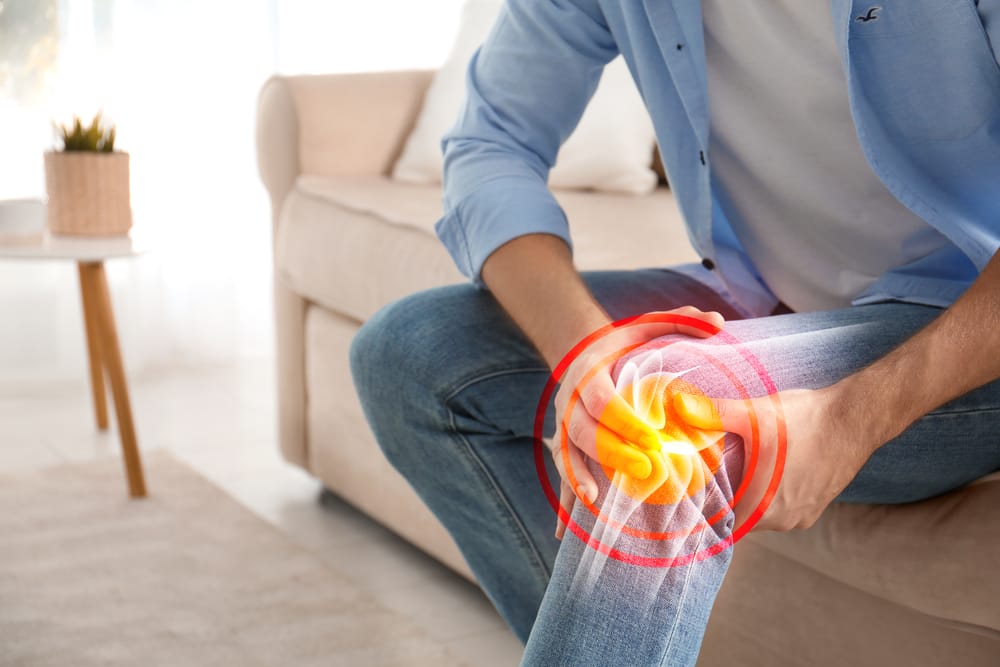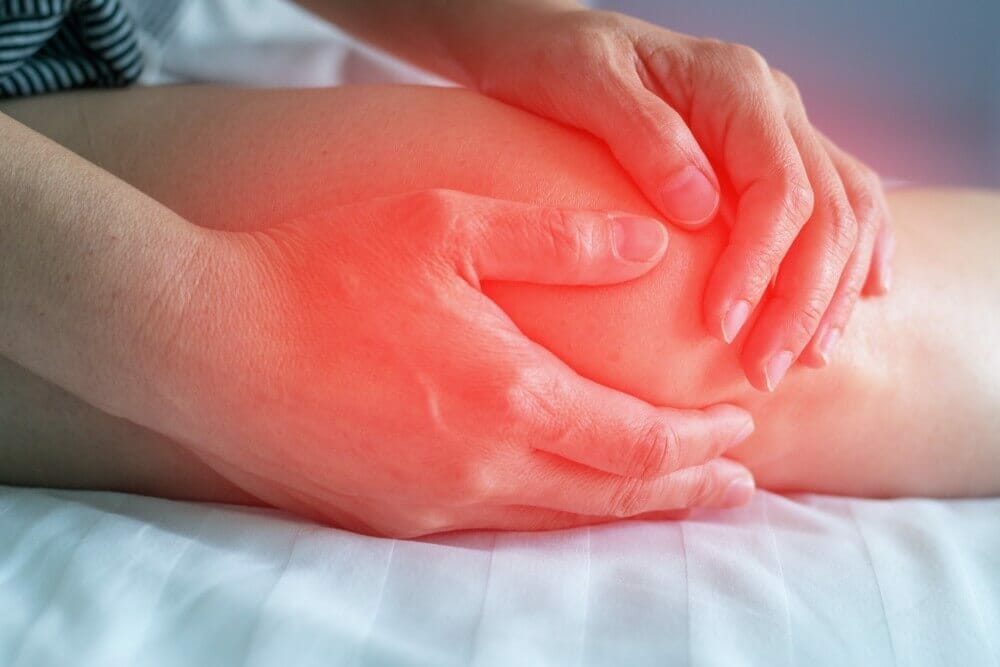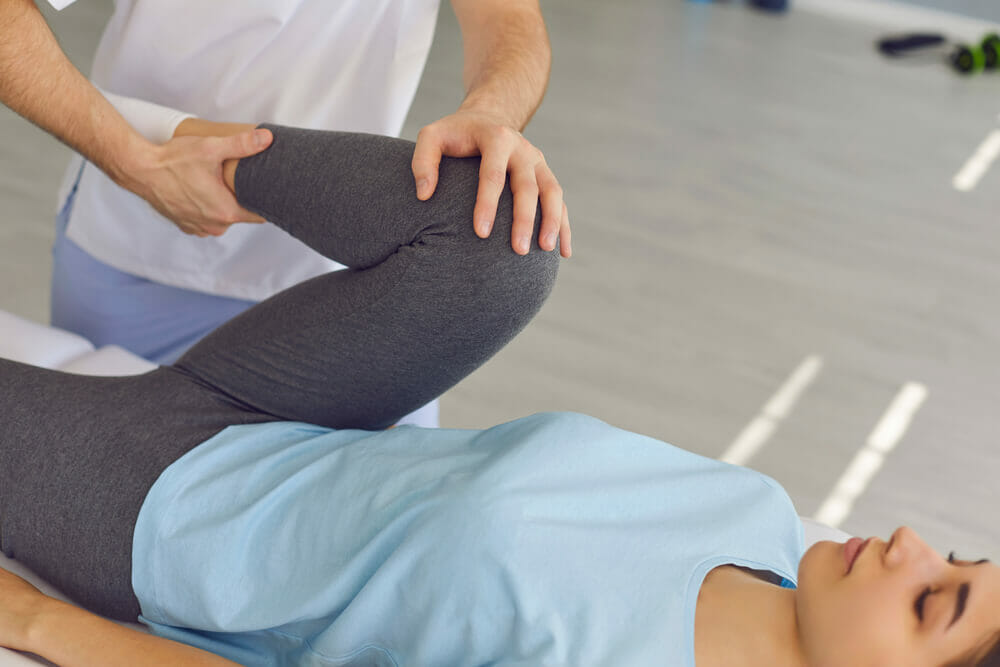
Experiencing knee pain? You’re not alone. Knee pain can be a frustrating issue, bringing inconvenience and discomfort to your daily life.
That’s what this knee pain guide is for: so that you can understand the signs, potential causes and, most importantly, what treatment options are available to you.
Understanding knee pain
Every time you walk, run, or even just stand, your knees play a pivotal role. It’s no wonder that sometimes they protest! But what exactly is happening in there?
The knee is comprised of bones, cartilage, ligaments, and tendons that all work together to facilitate vital movements like walking, running, or jumping. The femur (thigh bone), tibia (shin bone), and patella (knee cap) are the primary bones involved.
Cartilage acts as a cushion, preventing bones from rubbing against each other, while ligaments provide stability by connecting these bones. Tendons, on the other hand, link muscles to the bones, enabling the force required for movement. Together, these components work in harmony, allowing the knee to flex, extend, and even slightly rotate, supporting our daily activities and adventurous endeavours.
Causes of knee pain
The origins of knee pain can be complex and multifaceted, but here are a few common causes of knee pain.
Arthritis
A term familiar to many, arthritis is an inflammation of one or more joints. Osteoarthritis, a common type of arthritis that’s akin to wear and tear, is especially common in the knees. Over time, the cartilage in the knee can deteriorate, causing the joint to become irritated and inflamed. The result? Pain, swelling, and reduced motion.
Think of it like the hinges of an old door; without proper lubrication and care, they creak and resist smooth movement.
Sporting injury
Ah, the thrill of sports! Whether it’s a Sunday football game, intense round of tennis, or that unforgettable cricket game, sport plays a big part in Aussie culture. But it can also occasionally lead to knee injuries like torn ligaments, meniscus tears, or even fractures. A sprint to the finish or a swift move to dodge an opponent can sometimes be a recipe for knee troubles.
Mechanical problems
The human body is a marvel of engineering. But like any complex machine, things can go awry. A dislocated knee cap, a piece of broken cartilage, or even the way your feet function can impact your knees.
For instance, if you have flat or even high arched feet, you might exert more pressure on your knees. Or consider an old injury, one that you might’ve brushed off at the time. It can resurface as a mechanical problem, reminding you of its existence every time you take a step.
General knee injuries and overuse
There are a range of other more general injuries that can happen as a result of simply living your everyday life. These can include:
- Bursitis: a result of continuous pressure on the knee due to prolonged kneeling, excessive use, or injury leading to inflammation
- Tendinitis: inflammation of the tendon, often associated with a change in activity patterns, either due to overexertion or weakened tissue
- Knee cap dislocation
- Knee cap or other bone fractures
- Illiotibial Band Syndrome and Friction Syndrome: damage or irritation to the robust band extending from the hip to your knee’s other side
- Patellofemoral Syndrome: discomfort at the front of the knee, surrounding the knee cap
- Ligament tear: injuries to the anterior cruciate ligament (ACL) or the medial collateral ligament (MCL) that might lead to bleeding, swelling, or a shaky knee
- Cartilage tear (Meniscus Tear): pain typically sensed on the knee joint’s inner or outer regions
- Strains or sprains: minor ligament damage due to abrupt or abnormal twisting
Symptoms of knee pain
If you’ve got knee pain, you’ll probably know about it. But here are some common symptoms to look out for.
- Knee pain: especially around the kneecap, which often intensifies with activity and may persist even after rest.
- Swelling or stiffness: this indicates potential underlying issues, from a simple strain to more serious conditions like arthritis.
- Redness or warmth to the touch: this suggests possible infection or inflammation.
- Weakness or instability: a sensation of the knee buckling or not supporting your weight might hint at ligament injuries or structural problems.
- Popping or crunching noises: these can be normal, but if they’re persistent and accompanied by pain, it can indicate something else, like meniscus tears or worn-out cartilage.
- Unable to fully straighten your knee: this can stem from acute injuries to chronic conditions.
- Quadriceps weakness: weakness in the quadriceps muscle affects your knee’s ability to straighten completely.
The role of physiotherapy treatment for knee pain
Physical therapy can play a big role in understanding your knee pain and getting accurate treatment. Here’s how:
Accurate diagnosis
Physiotherapists are trained professionals who can expertly evaluate your physical condition. They can pinpoint the root cause of your discomfort to ensure your treatment is tailored to your specific problem.
Personalised treatment plans
Everyone’s pain is unique, and can be impacted by a range of factors including age, activity level, and the severity of the pain. Your knee physiotherapist will create a customised rehabilitation plan that caters to your individual needs.
Pain reduction
One of the primary goals of physical therapy is pain alleviation. Through techniques like manual therapy, physiotherapists can significantly reduce or even eliminate your pain. They can also guide you on pain relief methods to use at home.
Improved mobility
Knee pain often restricts mobility. A physio’s intervention can help enhance your range of motion in the knee joint so that you can move more freely. You’ll also likely see an improvement in your knee’s flexibility through curated exercises.
Muscle strengthening
Strengthening the muscles around your knee is pivotal in both recovery and prevention. By introducing targeted exercises, physiotherapists ensure that the muscles supporting the knee, like the gluteals, quadriceps and hamstrings, are robust. And a strong muscular system around the knee reduces strain on the joint itself, minimising the risk of future injuries.
Education
Education is a cornerstone of physiotherapy. Professionals offer invaluable insights into the anatomy of the knee, how it functions, and common ailments that can afflict it. By understanding your body better, you’ll feel more empowered to take proactive measures in your care and prevention strategies.
Gait training
Irregular walking patterns can make knee issues worse. Physiotherapists can help identify and correct these irregularities, ensuring that the knee isn’t subjected to undue stress. They can also educate you on the use of aids like braises or orthotics if necessary.
Holistic care
Physiotherapists often adopt a whole-body approach. This means that they may address related issues like posture of foot mechanics that could be contributing to knee pain, achieving more comprehensive care.
Post-surgery rehabilitation
If you’ve undergone surgery, like knee replacement surgery, physiotherapy is essential to the rehabilitation process. Through guided exercises and therapies, your physiotherapist can ensure that you recover optimally and regain full function of your knee.
Physiotherapy treatment for knee pain
Manual therapy
This involves a range of hands-on techniques used by your physio to alleviate pain, increase mobility, and improve function. It often involves mobilising joints, manipulating soft tissues, and stretching muscles. By applying specific pressure or movements to problematic areas, manual therapy can relieve tension, improve circulation, and enhance joint function, offering you relief from discomfort and increased range of motion.
Exercise therapy
This revolves around prescribing specific exercises to strengthen muscles, improve flexibility, and enhance overall physical function. Tailored to your needs, these exercises address the root causes of pain and mobility issues. Whether it’s strengthening weak muscles, retraining posture, or improving balance, exercise therapy plays a vital role in rehabilitation and long-term wellbeing. It also promotes self-management and the prevention of future injuries.
Aquatic therapy
Aquatic therapy takes physiotherapy into the water, using the buoyancy, resistance, and therapeutic properties to allow you to perform exercises without putting excessive strain on your joints. It’s especially beneficial for those with arthritis, post-surgical patients, and those with mobility issues.
Dry needling
Dry needling involves inserting fine needles into specific points on the body, targeting muscular knots or trigger points causing pain. By releasing these tight spots in the muscles, dry needling can effectively relieve pain, reduce muscle tension, and improve range of motion.
READ MORE: Dry needling vs acupuncture – what’s the difference?
Joint mobilisation
This is a manual technique where physiotherapists apply specific, controlled movements to your knee, aiming to restore function and reduce knee joint pain. By moving the joint in specific directions and amplitudes, therapists can increase its range of motion, relieve joint stiffness, and improve overall mobility. This technique is beneficial for those with arthritis or post-injury stiffness.
Home remedies for knee pain
Pain relief and management
Cold and heat therapy
Both cold and heat can play a role in helping with knee pain management. Cold therapy involves applying cold packs or ice to the affected area. It works by constricting blood vessels and reducing blood flow to the area, which can help decrease inflammation, numb the region, and alleviate pain. Use cold therapy during the first 48 hours after an injury, but never place ice directly onto the skin.
Heat therapy does the opposite. It dilates the blood vessels, promotes blood flow, and relaxes and soothes muscle tissues. Applying a warm towel or a heat pad can help reduce muscle spasms and ease pain in the knee, particularly if the pain is due to conditions with muscle tension. Heat is also beneficial for chronic pain or stiffness – but it should not be used on a fresh injury or an inflamed knee, as it can make it worse.
READ MORE: When to use heat or ice for an injury
Over-the-counter pain relief
Over-the-counter (OTC) pain relief can offer temporary respite from knee pain. Non-steroidal anti-inflammatory drugs (NSAIDs) like ibuprofen and naproxen are popular choices because they work to relieve pain and reduce inflammation. Something like paracetamol can also help, although it doesn’t offer the anti-inflammatory benefits of NSAIDs.
Knee support
Knee supports, often in the form of braces, sleeves, or straps, can provide relief by offering additional stability and reducing strain on the knee joint. Here’s a breakdown:
- Knee sleeves: these slide over the knee and provide compression, which can help reduce swelling and offer mild support.
- Knee braces: braces are more robust supports that are designed to protect the knee from further injury, especially post-surgery or if there’s a known ligament issue. They can limit certain movements and provide added stability.
- Patellar straps: these are small bands that sit just below the kneecap and can help with conditions like patellar tendonitis (jumper’s knee) by providing compression on the tendon.
Stretches for knee pain
Calf stretch
Using a wall for support, place your hands on the wall and step one foot back, keeping it straight and pressing the heel into the floor.
Hamstring stretch
Sit on the floor with one leg extended out and the other bent inward. Reach toward the toes of the extended leg until you feel a stretch in the back of your thigh.
Quadriceps stretch
Standing next to a wall for balance, grab your ankle behind you and gently pull it towards your glute feeling a stretch in the front of your thigh.
Inner thigh stretch
Sit with the soles of your feet together, holding your ankles. Gently press your knees towards the ground using your elbows.
Knee-to-chest stretch
Lying on your back, pull one knee towards your chest, holding it with both hands. Feel a stretch in your lower back and glutes.
Piriformis stretch
Lying on your back, cross one ankle over the opposite knee. Hold the thigh of the bottom leg and pull it towards your chest, feeling a stretch in the outer hip.

Knee pain prevention
Exercises for knee pain
Engaging in regular exercises can help alleviate knee pain by strengthening the muscles around the knee, improving flexibility, and enhancing joint stability. Look at incorporating some of these into your routine.
Quad sets
Sit with your legs extended in front of you. Tighten the quadriceps (muscles in front of your thigh) and press the back of your knee down towards the floor. Hold for a few seconds and release.
Straight leg raises
Lying down on your back, bend one knee and keep the other leg straight. Tighten up your quadriceps and lift the straight leg up to the height of the bent knee. Lower it down slowly.
Wall squats
Stand with your back against a wall, feet shoulder-width apart. Slowly slide down the wall into a squatting position, ensuring your knees don’t extend past your toes. Hold and then slide back up.
Step-ups
Using a low step or a sturdy platform, step up with one foot followed by the other, then step down in the same sequence.
Heel raises
Standing upright, slowly lift your heels off the ground and rise onto your toes. Lower them back down gently.
Bridges
Lie on your back with knees bent and feet flat on the floor. Tighten your gluteal muscles and lift your hips off the floor. Hold, then lower back down.
Clamshells
Lying on your side with knees bent at a 90-degree angle, keep your feet together and lift the top knee as high as you can without shifting your pelvis. Lower and repeat.
Lifestyle changes
Addressing knee pain sometimes requires a broader look at your lifestyle. Look at some of these things.
- Maintain a healthy weight. This reduces pressure on the knees and prevents wear and tear of the knee joints.
- Wear supportive footwear. This is crucial for those standing or walking extensively. The right footwear can significantly alleviate knee stress.
- Ensure good workplace ergonomics. If you work a desk-based job, this is essential. Ensure your chair and desk heights allow your feet to rest flat on the floor and your knees to maintain a 90-degree angle.
- Eat a balanced diet. Look at eating anti-inflammatory foods to support joint health like leafy greens, nuts, and fatty fish.
READ MORE: How the Mediterranean diet can help with arthritis
Take control of your knee pain today
Knee pain can be more than just a physical hindrance; it can limit your activities, dampen your spirits, and generally impact your overall quality of life. But whether you’re experiencing the occasional twinge or persistent discomfort, remember you don’t have to navigate this journey alone!
We hope you’ve found this knee pain guide helpful, and remember, our team of experienced knee physiotherapists is here to provide tailored solutions. Book an appointment with Integrity Physio Como today!



